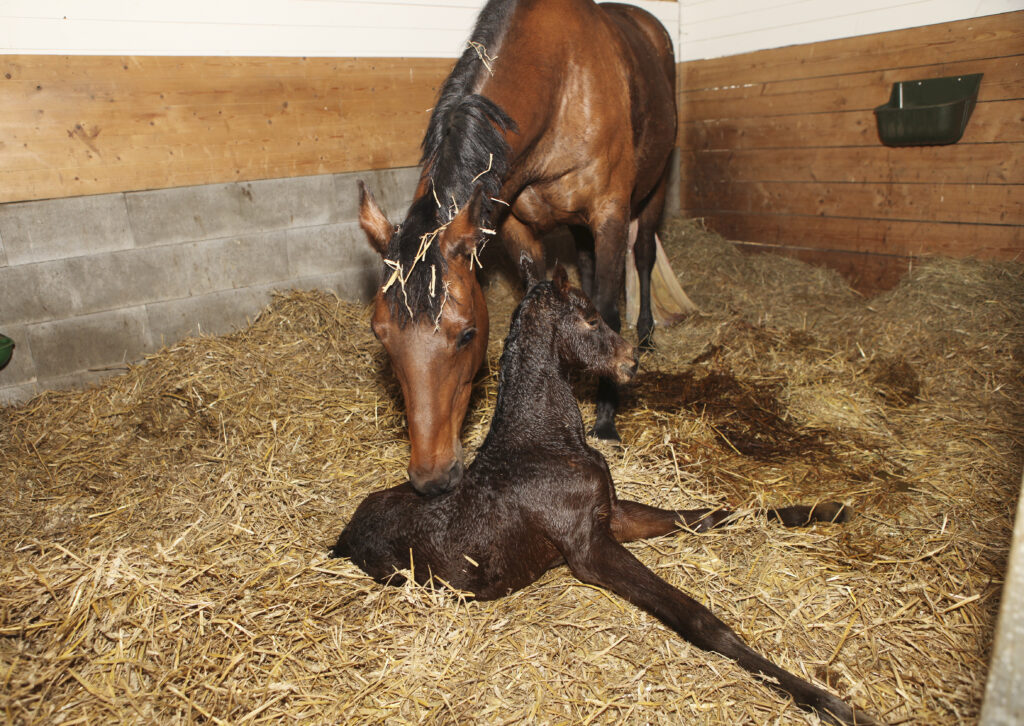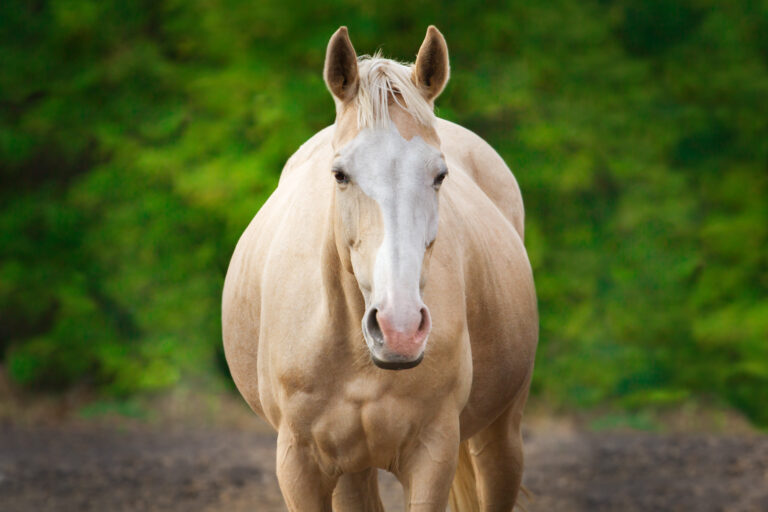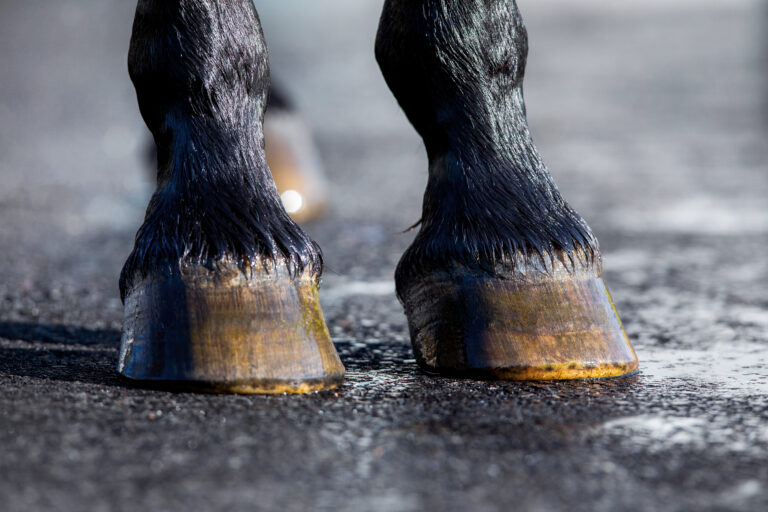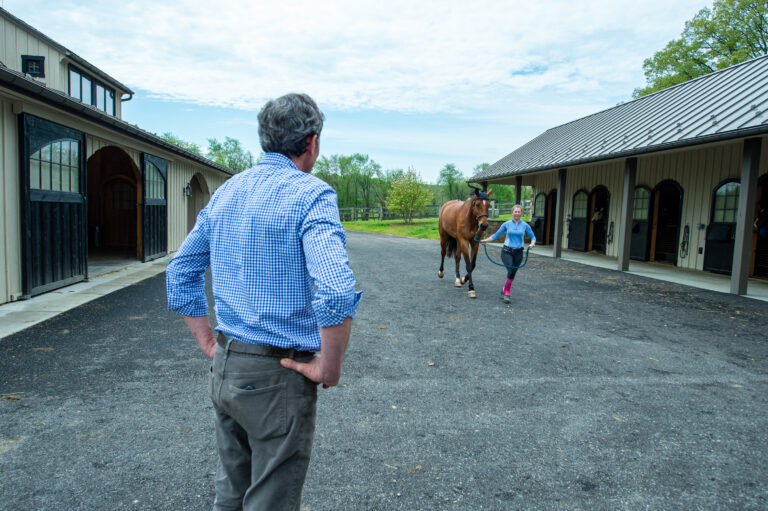
In this episode, Laura Javsicas, VMD, Dipl. ACVIM, joined us to discuss neonatal field care. During the conversation, she described her standard newborn foal examination, listed common conditions she encounters with neonates, and discussed conditions that might require referral to a hospital.
Newborn Foal Examination
Javsicas said she likes to examine newborn foals between eight to 12 hours after birth. That way, if she detects a low IgG, she can supplement with colostrum (if available) in the window during which they will still absorb it. If she can’t examine a foal within that window, she likes to look at them before 24 hours of age, assuming the foal is doing well clinically.
During the newborn foal examination, Javsicas always checks CBC and IgG at a minimum, and she said some farms also run an SAA test. For the physical exam, she first observes the foal from outside the stall. “You can really learn a lot about if they have normal behavior and if you detect any issues just by watching them,” she said.
If the foal is up, she makes sure it is interested in nursing and aware of its surroundings. After observing the foal from outside the stall, she does a complete physical examination, including looking at mucous membranes and the tongue. She explained some sick foals can develop candida on the surface of the tongue. She palpates the palate carefully and looks at the sclera of the eyes for any signs of hemorrhage. She palpates the ribs carefully and checks the umbilicus for large hernias. She also palpates all the joints. She likes to watch the foal ambulate, and she looks closely at the foal’s coronary bands, where redness can develop in septic foals. She noted it’s always important to get a temperature as well.
Milestones for Neonates
Javsicas then discussed some milestones newborn foals should reach shortly after birth. Foals should be standing within one hour, nursing within two hours, and passing meconium within three hours. She said foals should develop a suckle reflex between five and 20 minutes after birth, and they should be able to sit sternal by about 10 minutes.
Javsicas said a normal foal should nurse at least once per hour, and most healthy foals nurse twice an hour. She said decreased nursing activity is a big red flag. If a foal is standing at the mare for long periods and trying to nurse continuously, the mare might not be producing enough milk.
Red Flags for Neonates
In addition to breaks from any of the above milestones, Javsicas said the biggest red flag for a newborn foal is decreased nursing activity. “This is a very nonspecific sign, but it is a huge concern because foals can become dehydrated and hypoglycemic fairly quickly,” she said.
Her top differentials for decreased nursing activity are septicemia, neonatal maladjustment, and enterocolitis. She checks these foals for signs of diarrhea.
Javsicas said it is also concerning if a foal is acting interested in nursing but nursing on incorrect objects, such as stifles.
Another red flag she often observes is an increased respiratory rate, which can be a sign of fractured ribs, especially if the foal doesn’t want to lie down or the respiratory rate increases while the foal is lying down.
Javsicas also commonly observes foals straining to urinate or defecate, which she says often confuses owners. “They know the foal is straining, but they may not know what they’re straining to do,” she said. If a foal is straining to urinate, she worries about a ruptured bladder, especially if it’s a colt. If the foal is straining to defecate, she worries about meconium impactions, which are the most common cause of colic in the first 24 hours of life.
“It’s important to ask if the foal has passed meconium,” she said. “However, they certainly can have an impaction that is significant enough to cause clinical signs even if they did pass some amount of normal meconium.”
Flexural deformities, such as severely contracted or lax tendons, are other common problems in neonates. In those cases, Javsicas is most concerned about whether the condition affects the foal’s ability to nurse as frequently as it needs to.
Conditions That Require Hospitalization
Javsicas said it is difficult to generalize about which foals require hospitalization to treat certain conditions because cases depend on the available farm staff and their capabilities. However, she said it’s never wrong to refer a foal you have health concerns about, especially if the owner doesn’t have capable staff on the farm who can observe the foal frequently.
Javsicas generally feels comfortable addressing meconium impactions on the farm, but if the condition is not improving and the foal becomes distended or has gastric reflux, she prefers to refer them. She also likes to refer foals with diarrhea that aren’t nursing well due to electrolyte abnormalities. She often addresses failure of passive transfer on the farm. Foals with severely contracted tendons that can’t stand to nurse should be managed in a hospital, but less severe cases can be managed on the farm. Fractured ribs over the heart sometimes require referral and surgical intervention.
About Dr. Laura Javsicas
Laura Javsicas, VMD, Dipl. ACVIM, grew up outside Philadelphia, Pennsylvania, where she enjoyed riding hunters and jumpers. She received a bachelor’s degree in biology from Cornell University, where she was co-captain of the equestrian team. Javsicas then returned to Philadelphia to attend veterinary school at the University of Pennsylvania.
After receiving her VMD in 2004, she did a one-year internship at the Hagyard Equine Medical Institute in Lexington, Kentucky, which furthered her interest in critical care medicine and neonatology. Javsicas then completed a three-year residency in equine internal medicine at the University of Florida. Following her residency, she stayed on at the University of Florida as a member of the faculty. In 2009, she moved to Saratoga Springs, New York, where she worked at an equine clinic providing in-hospital internal medicine services and general ambulatory care until joining Rhinebeck Equine in 2013.
Javsicas is board-certified by the American College of Veterinary Internal Medicine in Large Animal Internal Medicine and has special interests in neonatology, ultrasonography, cardiology, gastrointestinal diseases, and emergency/critical care medicine.

![[Aggregator] Downloaded image for imported item #18375](https://s3.amazonaws.com/wp-s3-equimanagement.com/wp-content/uploads/2025/09/30140031/EDCC-Unbranded-26-scaled-1-768x512.jpeg)


